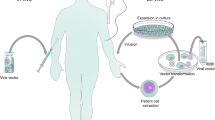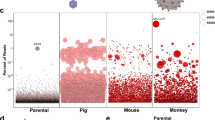Abstract
The adeno-associated virus (AAV) is one of the most promising viral vectors for human gene therapy. As with any potential therapeutic system, a thorough understanding of it at the in vitro and in vivo levels is required. Over the years, numerous methods have been developed to better characterize AAV vectors. These methods have paved the way to a better understanding of the vector and, ultimately, its use in clinical applications. This review provides an up-to-date, detailed description of essential methods such as production, purification and titering and their application to characterize current AAV vectors for preclinical and clinical use.
This is a preview of subscription content, access via your institution
Access options
Subscribe to this journal
Receive 12 print issues and online access
$259.00 per year
only $21.58 per issue
Buy this article
- Purchase on Springer Link
- Instant access to full article PDF
Prices may be subject to local taxes which are calculated during checkout













Similar content being viewed by others
References
Xiao, X., Li, J. & Samulski, R.J. Production of high-titer recombinant adeno-associated virus vectors in the absence of helper adenovirus. J. Virol. 72, 2224–2232 (1998).
Grimm, D., Kern, A., Rittner, K. & Kleinschmidt, J.A. Novel tools for production and purification of recombinant adenoassociated virus vectors. Hum. Gene Ther. 9, 2745–2760 (1998).
Collaco, R.F., Cao, X. & Trempe, J.P. A helper virus-free packaging system for recombinant adeno-associated virus vectors. Gene 238, 397–405 (1999).
Matsushita, T. et al. Adeno-associated virus vectors can be efficiently produced without helper virus. Gene Ther. 5, 938–945 (1998).
Salvetti, A. et al. Factors influencing recombinant adeno-associated virus production. Hum. Gene Ther. 9, 695–706 (1998).
Zhang, X. et al. High-titer recombinant adeno-associated virus production from replicating amplicons and herpes vectors deleted for glycoprotein H. Hum. Gene Ther. 10, 2527–2537 (1999).
Clark, K.R., Voulgaropoulou, F., Fraley, D.M. & Johnson, P.R. Cell lines for the production of recombinant adeno-associated virus. Hum. Gene Ther. 6, 1329–1341 (1995).
Clark, K.R. Recent advances in recombinant adeno-associated virus vector production. Kidney Int. 61, 9–15 (2002).
Gao, G.P. et al. High-titer adeno-associated viral vectors from a Rep/Cap cell line and hybrid shuttle virus. Hum. Gene Ther. 9, 2353–2362 (1998).
Zhang, X. & Li, C.Y. Generation of recombinant adeno-associated virus vectors by a complete adenovirus-mediated approach. Mol. Ther. 3, 787–792 (2001).
Zhang, H.G. et al. Recombinant adenovirus expressing adeno-associated virus cap and rep proteins supports production of high-titer recombinant adeno-associated virus. Gene Ther. 8, 704–712 (2001).
Conway, J.E. et al. High-titer recombinant adeno-associated virus production utilizing a recombinant herpes simplex virus type I vector expressing AAV-2 Rep and Cap. Gene Ther. 6, 986–993 (1999).
Qiao, C., Wang, B., Zhu, X., Li, J. & Xiao, X. A novel gene expression control system and its use in stable, high-titer 293 cell-based adeno-associated virus packaging cell lines. J. Virol. 76, 13015–13027 (2002).
Inoue, N. & Russell, D.W. Packaging cells based on inducible gene amplification for the production of adeno-associated virus vectors. J. Virol. 72, 7024–7031 (1998).
Urabe, M., Ding, C. & Kotin, R.M. Insect cells as a factory to produce adeno-associated virus type 2 vectors. Hum. Gene Ther. 13, 1935–1943 (2002).
Ruffing, M., Zentgraf, H. & Kleinschmidt, J.A. Assembly of viruslike particles by recombinant structural proteins of adeno-associated virus type 2 in insect cells. J. Virol. 66, 6922–6930 (1992).
Samulski, R.J., Chang, L.S. & Shenk, T. A recombinant plasmid from which an infectious adeno-associated virus genome can be excised in vitro and its use to study viral replication. J. Virol. 61, 3096–3101 (1987).
Gao, G., Vandenberghe, L.H. & Wilson, J.M. New recombinant serotypes of AAV vectors. Curr. Gene Ther. 5, 285–297 (2005).
Choi, V.W., McCarty, D.M. & Samulski, R.J. AAV hybrid serotypes: improved vectors for gene delivery. Curr. Gene Ther. 5, 299–310 (2005).
Gao, G. et al. Purification of recombinant adeno-associated virus vectors by column chromatography and its performance in vivo. Hum. Gene Ther. 11, 2079–2091 (2000).
Zolotukhin, S. et al. Recombinant adeno-associated virus purification using novel methods improves infectious titer and yield. Gene Ther. 6, 973–985 (1999).
Summerford, C. & Samulski, R.J. Membrane-associated heparan sulfate proteoglycan is a receptor for adeno-associated virus type 2 virions. J. Virol. 72, 1438–1445 (1998).
Walters, R.W., Pilewski, J.M., Chiorini, J.A. & Zabner, J. Secreted and transmembrane mucins inhibit gene transfer with AAV4 more efficiently than AAV5. J. Biol. Chem. 277, 23709–23713 (2002).
Rabinowitz, J.E. et al. Cross-dressing the virion: the transcapsidation of adeno-associated virus serotypes functionally defines subgroups. J. Virol. 78, 4421–4432 (2004).
Kaludov, N., Handelman, B. & Chiorini, J.A. Scalable purification of adeno-associated virus type 2, 4, or 5 using ion-exchange chromatography. Hum. Gene Ther. 13, 1235–1243 (2002).
Grieger, J.C. & Samulski, R.J. Packaging capacity of adeno-associated virus serotypes: impact of larger genomes on infectivity and postentry steps. J. Virol. 79, 9933–9944 (2005).
Clark, K.R., Voulgaropoulou, F. & Johnson, P.R. A stable cell line carrying adenovirus-inducible rep and cap genes allows for infectivity titration of adeno-associated virus vectors. Gene Ther. 3, 1124–1132 (1996).
Samulski, R.J. & Shenk, T. Adenovirus E1B 55-Mr polypeptide facilitates timely cytoplasmic accumulation of adeno-associated virus mRNAs. J. Virol. 62, 206–210 (1988).
McCarty, D.M. et al. Adeno-associated virus terminal repeat (TR) mutant generates self-complementary vectors to overcome the rate-limiting step to transduction in vivo. Gene Ther. 10, 2112–2118 (2003).
Zolotukhin, S. Production of recombinant adeno-associated virus vectors. Hum. Gene Ther. 16, 551–557 (2005).
Choi, V.W., Asokan, A., Haberman, R.A., McCown, T.J. & Samulski, R.J. Production of Recombinant Adeno-Associated Viral Vectors and Use in In Vitro and In Vivo Administration (John Wiley and Sons, Winston-Salem, North Carolina, 2006).
Ferrari, F.K., Samulski, T., Shenk, T. & Samulski, R.J. Second-strand synthesis is a rate-limiting step for efficient transduction by recombinant adeno-associated virus vectors. J. Virol. 70, 3227–3234 (1996).
Atchison, R.W., Casto, B.C. & Hammon, W.M. Adenovirus-associated defective virus particles. Science 149, 754–756 (1965).
Chen, S. et al. Efficient transduction of vascular endothelial cells with recombinant adeno-associated virus serotype 1 and 5 vectors. Hum. Gene Ther. 16, 235–247 (2005).
Chao, H., Monahan, P.E., Liu, Y., Samulski, R.J. & Walsh, C.E. Sustained and complete phenotype correction of hemophilia B mice following intramuscular injection of AAV1 serotype vectors. Mol. Ther. 4, 217–222 (2001).
Hoggan, M.D., Blacklow, N.R. & Rowe, W.P. Studies of small DNA viruses found in various adenovirus preparations: physical, biological, and immunological characteristics. Proc. Natl. Acad. Sci. USA 55, 1467–1474 (1966).
Fu, H. et al. Self-complementary adeno-associated virus serotype 2 vector: global distribution and broad dispersion of AAV-mediated transgene expression in mouse brain. Mol. Ther. 8, 911–917 (2003).
Wang, Z. et al. Rapid and highly efficient transduction by double-stranded adeno-associated virus vectors in vitro and in vivo. Gene Ther. 10, 2105–2111 (2003).
Liu, Y. et al. Specific and efficient transduction of Cochlear inner hair cells with recombinant adeno-associated virus type 3 vector. Mol. Ther. 12, 725–733 (2005).
Parks, W.P., Green, M., Pina, M. & Melnick, J.L. Physicochemical characterization of adeno-associated satellite virus type 4 and its nucleic acid. J. Virol. 1, 980–987 (1967).
Chiorini, J.A., Yang, L., Liu, Y., Safer, B. & Kotin, R.M. Cloning of adeno-associated virus type 4 (AAV4) and generation of recombinant AAV4 particles. J. Virol. 71, 6823–6833 (1997).
Liu, G., Martins, I.H., Chiorini, J.A. & Davidson, B.L. Adeno-associated virus type 4 (AAV4) targets ependyma and astrocytes in the subventricular zone and RMS. Gene Ther. 12, 1503–1508 (2005).
Bantel-Schaal, U. & zur Hausen, H. Characterization of the DNA of a defective human parvovirus isolated from a genital site. Virology 134, 52–63 (1984).
Chiorini, J.A., Kim, F., Yang, L. & Kotin, R.M. Cloning and characterization of adeno-associated virus type 5. J. Virol. 73, 1309–1319 (1999).
Zabner, J. et al. Adeno-associated virus type 5 (AAV5) but not AAV2 binds to the apical surfaces of airway epithelia and facilitates gene transfer. J. Virol. 74, 3852–3858 (2000).
Lotery, A.J. et al. Adeno-associated virus type 5: transduction efficiency and cell-type specificity in the primate retina. Hum. Gene Ther. 14, 1663–1671 (2003).
Burger, C. et al. Recombinant AAV viral vectors pseudotyped with viral capsids from serotypes 1, 2, and 5 display differential efficiency and cell tropism after delivery to different regions of the central nervous system. Mol. Ther. 10, 302–317 (2004).
Apparailly, F. et al. Adeno-associated virus pseudotype 5 vector improves gene transfer in arthritic joints. Hum. Gene Ther. 16, 426–434 (2005).
Rutledge, E.A., Halbert, C.L. & Russell, D.W. Infectious clones and vectors derived from adeno-associated virus (AAV) serotypes other than AAV type 2. J. Virol. 72, 309–319 (1998).
Blankinship, M.J. et al. Efficient transduction of skeletal muscle using vectors based on adeno-associated virus serotype 6. Mol. Ther. 10, 671–678 (2004).
Halbert, C.L., Allen, J.M. & Miller, A.D. Efficient mouse airway transduction following recombination between AAV vectors carrying parts of a larger gene. Nat. Biotechnol. 20, 697–701 (2002).
Gao, G.P. et al. Novel adeno-associated viruses from rhesus monkeys as vectors for human gene therapy. Proc. Natl. Acad. Sci. USA 99, 11854–11859 (2002).
Gao, G. et al. Clades of Adeno-associated viruses are widely disseminated in human tissues. J. Virol. 78, 6381–6388 (2004).
Louboutin, J.P., Wang, L. & Wilson, J.M. Gene transfer into skeletal muscle using novel AAV serotypes. J. Gene Med. 7, 442–451 (2005).
Wang, Z. et al. Adeno-associated virus serotype 8 efficiently delivers genes to muscle and heart. Nat. Biotechnol. 23, 321–328 (2005).
Wang, Z. et al. Widespread and stable pancreatic gene transfer by adeno-associated virus vectors via different routes. Diabetes 55, 875–884 (2006).
Pacak, C.A. et al. Recombinant adeno-associated virus serotype 9 leads to preferential cardiac transduction in vivo. Circ. Res. 99, E3–E9 (2006).
Mori, S., Wang, L., Takeuchi, T. & Kanda, T. Two novel adeno-associated viruses from cynomolgus monkey: pseudotyping characterization of capsid protein. Virology 330, 375–383 (2004).
Muramatsu, S., Mizukami, H., Young, N.S. & Rown, K.E. Nucleotide sequencing and generation of an infections clone of adeno-associated virus 3. Virology 221, 208–217 (1996).
Acknowledgements
We thank A. Asokan, M. Hirsh, C. Li and Z. Wu for helpful discussions and critical reading of the manuscript. This work was supported in part by US National Institutes of Health grants GM059299, HL051818 and HL066973 (awarded to R.J.S.).
Author information
Authors and Affiliations
Corresponding author
Rights and permissions
About this article
Cite this article
Grieger, J., Choi, V. & Samulski, R. Production and characterization of adeno-associated viral vectors. Nat Protoc 1, 1412–1428 (2006). https://doi.org/10.1038/nprot.2006.207
Published:
Issue Date:
DOI: https://doi.org/10.1038/nprot.2006.207
This article is cited by
-
Photoreceptors inhibit pathological retinal angiogenesis through transcriptional regulation of Adam17 via c-Fos
Angiogenesis (2024)
-
Large-scale purification of functional AAV particles packaging the full genome using short-term ultracentrifugation with a zonal rotor
Gene Therapy (2023)
-
Extra-viral DNA in adeno-associated viral vector preparations induces TLR9-dependent innate immune responses in human plasmacytoid dendritic cells
Scientific Reports (2023)
-
Postsynaptic synucleins mediate endocannabinoid signaling
Nature Neuroscience (2023)
-
Gene Therapy Activates Retinal Pigment Epithelium Cell Proliferation for Age-related Macular Degeneration in a Mouse Model
Current Medical Science (2023)
Comments
By submitting a comment you agree to abide by our Terms and Community Guidelines. If you find something abusive or that does not comply with our terms or guidelines please flag it as inappropriate.



